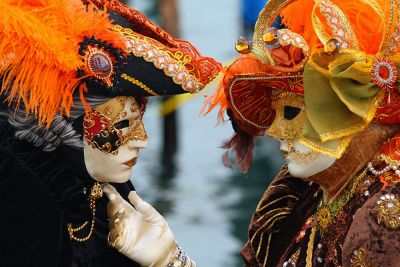Il Carnevale di Venezia, se non il più grandioso, è sicuramente il più conosciuto per il fascino che esercita ed il mistero che continua a possedere anche a 900 anni di distanza dal primo documento che fa riferimento a questa famosissima festa. Lungo le calli, per i canali e nei listoni, le maschere hanno sempre permesso di annullare l’identità personale, il sesso e la classe sociale per entrare a far parte della Grande Illusione in un posto, unico al mondo, dove tutto può accadere e dove ogni scorcio non cessa di incantare. Storicamente, la maschera non veniva utilizzata solo durante il periodo di Carnevale ma in molte occasioni durante l’anno.
As fall begins, the end of the year inches closer and so do the major holidays of the year. October is home to the exciting holiday of Halloween, a celebration which had begun many years ago and evolved overtime into the candy-giving, pumpkin-carving day we know of in modern times. Although the holiday is primarily celebrated in the U.S., other countries all over the world adopted certain aspects of the holiday.
Halloween is not widely celebrated in Italy, but it is slowly gaining in popularity. Italian children have been gradually finding Halloween practices such as carving pumpkins and trick-or-treating interesting and the holiday seems to have become more popular in more recent years. Italy has many holidays and festivals and Halloween would be yet another festival that Italians all over the nation can celebrate; however, a more popular mask-wearing holiday already takes place in Italy months before Halloween.
The Carnival of Venice is a celebration similar to Halloween that uses elaborate costumes and masks to illustrate the beauty of Venice and its people. This Italian celebration takes place right before Lent, which is a 40-day period where no meat is consumed. In fact, the Italian word Carnevale itself comes from the Latin words for meat (carne) and farewell (vale).
Started in 1162 but not officiated until the Renaissance, the Carnival of Venice had many rises and falls in popularity throughout the years until it was banned in 1797 under the rule of the King of Austria. Masks similar to the ones used in the festival were also forbidden. Luckily, the festival gained popularity once more in the 19th century and in 1979 the festival officially returned. The Italian government recognized and protected the tradition and it is still celebrated today.
The festivities that take place during the Carnival of Venice do hold a striking resemblance to Halloween, even though the origins of the two celebrations share nothing in common. Both celebrations include costumes, playing tricks, partying, and getting together for food and fun. Though these two events take place at different times of the year, they show similarities with how widely celebrated they are and how rambunctious participants may get during the times of merriment.
During Halloween, the best costume may be rewarded, but during the Carnival of Venice, the best mask is rewarded in the contest for la maschera più bella, or “the most beautiful mask.” Masks play a huge role during this festival. There are many different types of masks that people can craft during this festival including: the bauta, a gilded mask with a pointed chin which allows for talking and drinking, the colombina, a gold or silver and often feathered mask that only covers half of the wearer’s face and the Plague doctor mask, which is a beaked mask based on the supposed disease-preventing mask worn during the plague many centuries ago. Some masks may be halved, some may not be popular or in use anymore, but the creativity of the party-goers will always invent new designs to bring joy and surprise to those around them.
The next celebration of the Carnival of Venice won’t be until next year, but as Halloween approaches, it would be wise to keep the festival in close thoughts. Celebrations share certain aspects with other cultures and this truly unites the world with joy from all countries.



